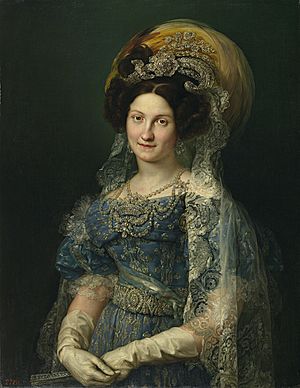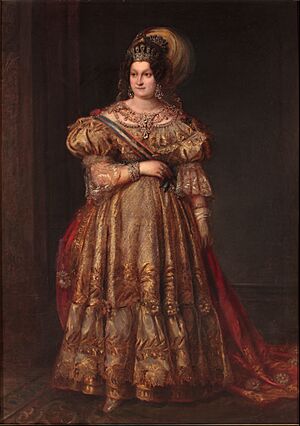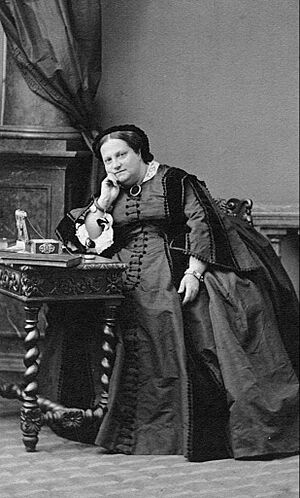Maria Christina of the Two Sicilies facts for kids
Quick facts for kids Maria Christina of the Two Sicilies |
|||||
|---|---|---|---|---|---|

Portrait by Vicente López y Portaña, 1830
|
|||||
| Queen consort of Spain | |||||
| Tenure | 11 December 1829 – 29 September 1833 | ||||
| Queen regent of Spain | |||||
| Regency | 29 September 1833 – 12 October 1840 | ||||
| Monarch | Isabella II | ||||
| Born | 27 April 1806 Palermo, Kingdom of Sicily |
||||
| Died | 22 August 1878 (aged 72) Le Havre, French Third Republic |
||||
| Burial | El Escorial | ||||
| Spouse | |||||
| Issue among others... |
|
||||
|
|||||
| House | Bourbon-Two Sicilies | ||||
| Father | Francis I of the Two Sicilies | ||||
| Mother | María Isabella of Spain | ||||
| Religion | Roman Catholicism | ||||
Maria Christina of the Two Sicilies (born 27 April 1806 – died 22 August 1878) was an important figure in Spanish history. She was the Queen of Spain from 1829 to 1833. After her husband, King Ferdinand VII of Spain, died, she became the queen regent for her young daughter, who was only nine years old. This period of her rule lasted from 1833 to 1840. Maria Christina helped introduce a new way of governing in Spain, which was similar to the system used in France at the time.
Contents
Early Life of Maria Christina
Maria Christina was born in Palermo, Sicily, on 27 April 1806. Her father was King Francis I of the Two Sicilies. Her mother was Maria Isabella of Spain, who was his second wife.
Becoming Queen of Spain
In 1829, King Ferdinand VII of Spain lost his third wife. He was getting old and was often sick. He did not have a son to take his place as king. This caused a big problem about who would rule next.
Ferdinand VII decided to marry again. His niece, Maria Christina, was suggested to him. She was young and had already had a child, which pleased the King. They were married on 12 December 1829.
When Maria Christina married Ferdinand VII, she became part of a big political fight in Spain. This fight was between two groups: the Liberals and the Carlists. The Liberals supported Maria Christina and wanted more modern government. The Carlists were very traditional and wanted Ferdinand's brother, Carlos, to be king.
The Carlists believed that women could not rule Spain. This was based on an old law called Salic law. But in 1789, King Charles IV had secretly changed this law. In 1830, Ferdinand VII officially announced this change. It was called the Pragmatic Sanction of 1830. This meant his daughters could become queen.
Maria Christina and Ferdinand VII had two daughters: Isabella, born in 1830, and Luisa Fernanda, born in 1832. The Pragmatic Sanction made sure Isabella could become queen.
In 1832, King Ferdinand VII became very ill. Maria Christina was worried about what would happen if he died. She was advised to make Carlos her chief adviser. She was also convinced to cancel the Pragmatic Sanction. This would have made Carlos the next king.
However, Ferdinand VII recovered. His sister-in-law, Luisa Carlotta, helped him. She convinced him to bring back the Pragmatic Sanction. This meant Isabella would still be the heir to the throne.
Maria Christina's Time as Regent

When King Ferdinand VII died on 29 September 1833, Maria Christina became the regent for her daughter, Isabella. Isabella was only a child. Carlos, Ferdinand's brother, still claimed he should be king. He said Ferdinand had illegally changed the law so his daughter could inherit the crown.
Carlos's attempt to become king led to a war called the First Carlist War. Many people supported Carlos, especially those who wanted to keep old traditions. But Maria Christina's side, called the "Isabelinos" (supporters of Isabella), won. They kept the throne for her daughter.
Challenges and Downfall
On 28 December 1833, Maria Christina secretly married Agustín Fernando Muñoz. He was an ex-sergeant from the royal guard. They had several children together.
- Maria de los Desamparados, Countess of Vista Alegre (1834 – 1864)
- Maria de los Milagros, Marchioness of Castillejo (1835 – 1903)
- Agustín Maria, 1st Duke of Tarancón (1837 – 1855)
- Fernando Maria, 2nd Duke of Riansares and Tarancon (1838 – 1910)
- Maria Cristina, Marchioness of La Isabella (1840 – 1921)
- Juan Bautista, Count of Recuerdo (1841 – 1863)
- Antonio Muñoz y de Borbón (1842 – 1847)
- Jose Maria, Count of Gracia (1843 – 1863)
If Maria Christina had made her marriage public, she would have lost her power as regent. However, many people at the Spanish court knew about her relationship with Muñoz.
Eventually, the news of her secret marriage to a common soldier became public. This made Maria Christina very unpopular. People also worried that she was not fully supporting the liberal government. Because of this, the army and the liberal leaders in the Spanish parliament (the Cortes) demanded that Maria Christina step down as regent. In 1840, she left Spain with Muñoz. General Baldomero Espartero took her place as regent.
Life in Exile
In 1842, Maria Christina bought the Château de Malmaison in France. In 1843, she returned to Spain with her husband. Her stepdaughter, Queen Isabella II, was declared old enough to rule in 1844.
Queen Isabella II gave Muñoz the title Duque de Riánsares. She also officially recognized her mother's marriage to Muñoz. Muñoz received other honors, including being made a Knight of the Golden Fleece. In 1854, Maria Christina left for France again. She lived there for the rest of her life.
Death and Burial
Maria Christina became ill again with coughing, fainting, and fever. She died in Le Havre, France, on 22 August 1878. As the mother of Queen Isabella II and the wife of King Ferdinand VII, Maria Christina was buried in the royal crypt at El Escorial in Spain.
Images for kids
See also
 In Spanish: María Cristina de Borbón-Dos Sicilias para niños
In Spanish: María Cristina de Borbón-Dos Sicilias para niños



